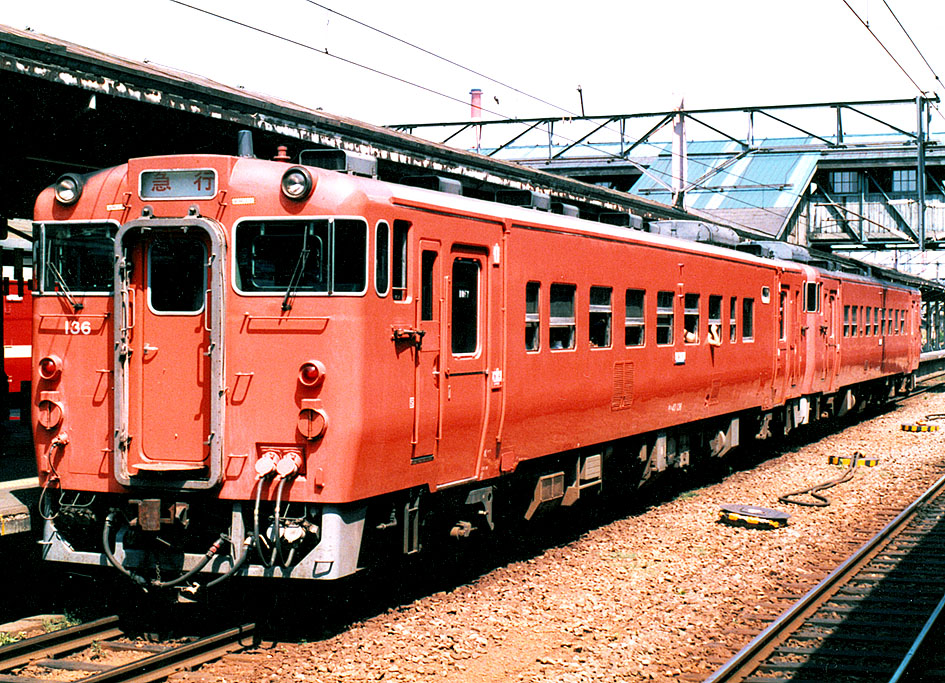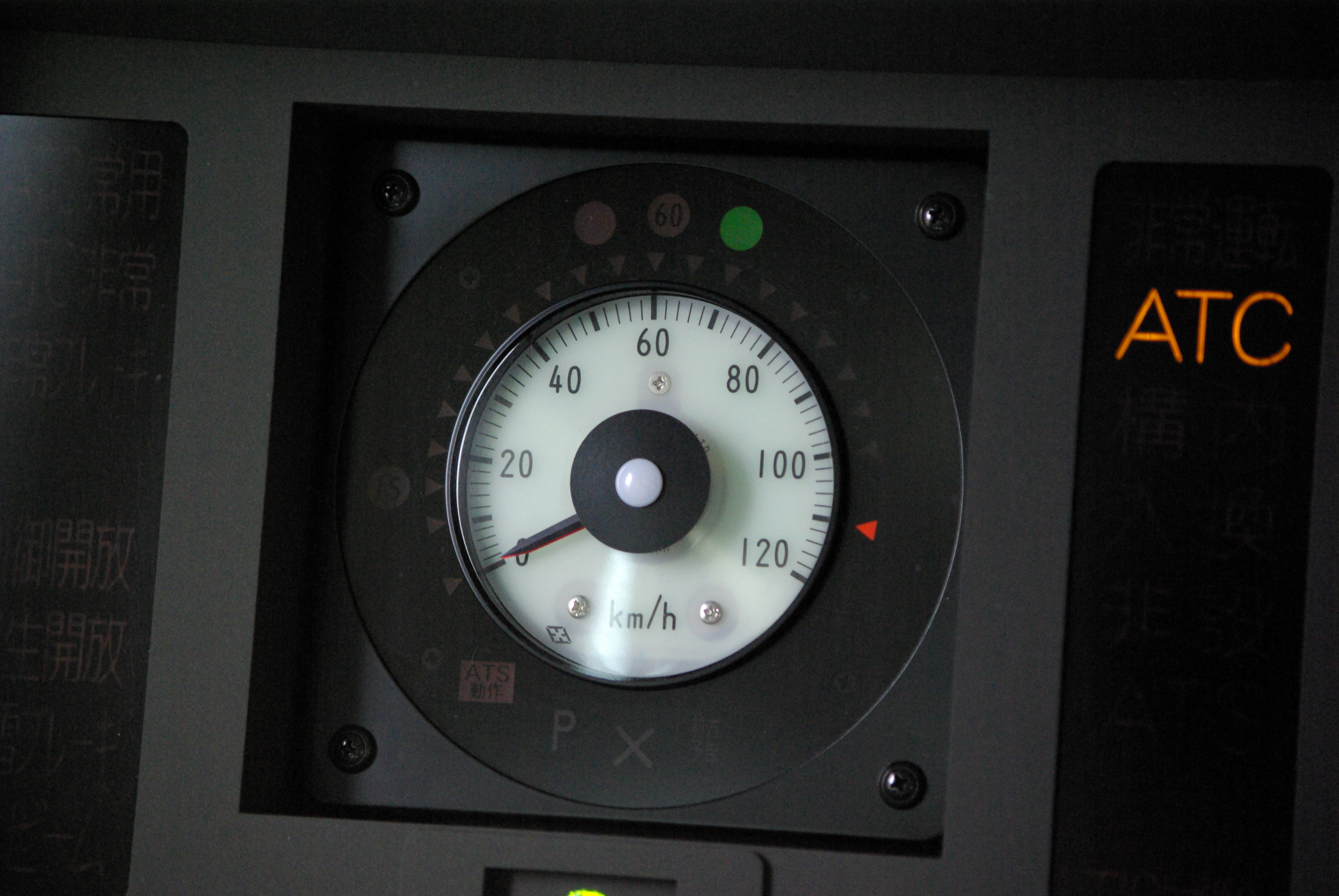|
AFM7
AFM7 is a Swedish passenger train car made by combining SJs 1980s-car with the drivers cab from the Rc5 locomotive and thus making it a control car. History Only three control cars of the type was made in 1988, they received the numbers 5543–5545. In the beginning the type was used on the Uppsalapendeln during the late 1980s and early 1990s. In the early 2000s, the type was used in Skåne in south of Sweden, but today it is once again used on the Uppsalapendeln, as it is one of the few lines left in Sweden that still run loco-hauled trains in regional traffic, particularly after the introduction of the ER1 trains in 2020-2021 on regional lines in the Mälaren Valley. The original designation for the type was UA7R, but since the "U" is indicating that the type is a DMU or EMU, it was changed to AF7x and then changed again to the current designation AFM7. Since the AFM7 does not have its own engine, it needs a Rc6 locomotive in order to be able to use the drivers cab. The ... [...More Info...] [...Related Items...] OR: [Wikipedia] [Google] [Baidu] |
Control Car
A control car, cab car (North America), control trailer, or driving trailer (UK, Ireland, Australia and India) is a non-powered rail vehicle from which a train can be operated. As dedicated vehicles or regular passenger cars, they have one or two driver compartments with all the controls and gauges required to remotely operate the locomotive, including exterior locomotive equipment such as horns, bells, ploughs, and lights. They also have communications and safety systems such as GSM-R or European Train Control System (ETCS). Control cars enable push-pull operation when located on the end of a train opposite its locomotive by allowing the train to reverse direction at a terminus without moving the locomotive or turning the train around. Control cars can carry passengers, baggage, and mail, and may, when used together with diesel locomotives, contain an engine-generator set to provide head-end power (HEP). They can also be used with a power car or a railcar. European railway ... [...More Info...] [...Related Items...] OR: [Wikipedia] [Google] [Baidu] |
Sweden
Sweden, formally the Kingdom of Sweden, is a Nordic countries, Nordic country located on the Scandinavian Peninsula in Northern Europe. It borders Norway to the west and north, and Finland to the east. At , Sweden is the largest Nordic country by both area and population, and is the List of European countries by area, fifth-largest country in Europe. Its capital and largest city is Stockholm. Sweden has a population of 10.6 million, and a low population density of ; 88% of Swedes reside in urban areas. They are mostly in the central and southern half of the country. Sweden's urban areas together cover 1.5% of its land area. Sweden has a diverse Climate of Sweden, climate owing to the length of the country, which ranges from 55th parallel north, 55°N to 69th parallel north, 69°N. Sweden has been inhabited since Prehistoric Sweden, prehistoric times around 12,000 BC. The inhabitants emerged as the Geats () and Swedes (tribe), Swedes (), who formed part of the sea-faring peopl ... [...More Info...] [...Related Items...] OR: [Wikipedia] [Google] [Baidu] |
SJ Rc
The Rc class is the most used electric locomotive in Sweden. Built by Allmänna Svenska Elektriska Aktiebolaget (ASEA), the Rc is a universal locomotive used both in freight and passenger trains. The largest operator is Green Cargo, although SJ, Tågab, Hector Rail and Banverket operate it as well. Previous operators include Veolia Transport. History The Rc-model emerged from ASEA in the 1960s. It first appeared in 1967 to replace the older D-locomotives. Notably, ASEA facility manager and head engineer Tore Nordin was involved in designing and developing the Rc locomotive at ASEA. The initial Rc models are notable for using thyristors instead of the older relay-based system. As of 2020, Rc-locomotives are still used all over Sweden in both passenger and freight lines, although on passenger trains they are slowly being replaced by new EMU, such as ER1. Versions Altogether, there have been eight versions of the Rc-locomotive in Sweden, including the freight locomotive Rm ... [...More Info...] [...Related Items...] OR: [Wikipedia] [Google] [Baidu] |
Skåne
Scania ( ), also known by its native name of Skåne (), is the southernmost of the historical provinces of Sweden, provinces () of Sweden. Located in the south tip of the geographical region of Götaland, the province is roughly conterminous with Skåne County, created in 1997. Like the other historical provinces of Sweden, Scania still features in colloquial speech and in cultural references, and can therefore not be regarded as an archaic concept. Within Scania there are 33 municipalities of Sweden, municipalities that are autonomous within the Skåne Regional Council. Scania's largest urban areas of Sweden, city, Malmö, is the third-largest city in Sweden, as well as the fifth-largest in Scandinavia. To the north, Scania borders the historical provinces of Halland and Småland, to the northeast Blekinge, to the east and south the Baltic Sea, and to the west Öresund. Since 2000, a road and railway bridge, the Öresund Bridge, bridges the Öresund, Sound and connects Scania ... [...More Info...] [...Related Items...] OR: [Wikipedia] [Google] [Baidu] |
Stadler KISS
The Stadler KISS is a family of bilevel rail car, bilevel electric multiple unit commuter trains developed and built since 2008 by Stadler Rail of Switzerland. As of 2016, 242 KISS trainsets comprising 1,145 cars have been sold to operators in eleven countries. Boarding is done into the lower deck. Name In the early stages of its development, the KISS was known as the Stadler DOSTO. This name was derived from the German word ''Doppelstock'', meaning "Bilevel rail car, double decker". This is still the name used for the Sweden, Swedish market because wikt:kiss#Swedish, "kiss" means "pee" in Swedish. Since September 2010, Stadler refers to the train as "KISS", an acronym for "''Komfortabler Innovativer Spurtstarker S-Bahn-Zug''", meaning "comfortable, innovative, sprint-capable rapid transit, suburban train". In Swiss Federal Railways (SBB) service, the train is Swiss locomotive and railcar classification, classified as RABe 511, while a newer version for regional services is clas ... [...More Info...] [...Related Items...] OR: [Wikipedia] [Google] [Baidu] |
Mälaren Valley
The Mälaren Valley (), occasionally referred to as Stockholm-Mälaren Region (''Stockholm-mälarregionen''), is the easternmost part of Svealand, the catchment area of Lake Mälaren and the surrounding municipalities. The term is often used interchangeably for the extended capital region of Sweden as Stockholm is located at the lake's eastern end, at its outlet in the Baltic Sea. Extent and characteristics The Mälaren Valley, which never has been defined as an official region, has throughout Swedish history instead been shared by several provinces — Uppland, Södermanland, Västmanland, and Närke — and, in modern times, by several counties — Stockholm, Uppsala, Södermanland, Örebro, and Västmanland. In most cases, the Lake Hjälmaren region is included into the Mälaren Valley Region, if nothing else, for historical and cultural reasons. Notwithstanding this, most people in Sweden will have a clear notion of what characterises the Mälaren Valley, while few ... [...More Info...] [...Related Items...] OR: [Wikipedia] [Google] [Baidu] |
Diesel Multiple Unit
A diesel multiple unit or DMU is a multiple-unit train powered by on-board diesel engines. A DMU requires no separate locomotive, as the engines are incorporated into one or more of the carriages. Diesel-powered single-unit railcars are also generally classed as DMUs. Diesel-powered units may be further classified by their transmission type: diesel–mechanical DMMU, diesel–hydraulic DHMU, or diesel–electric DEMU. Design The diesel engine may be located above the frame in an engine bay or under the floor. Driving controls can be at both ends, on one end, or in a separate car. Types by transmission DMUs are usually classified by the method of transmitting motive power to their wheels. Diesel–mechanical In a diesel–mechanical multiple unit (DMMU), the rotating energy of the engine is transmitted via a Transmission (mechanics), gearbox and driveshaft directly to the wheels of the train, like a automobile, car. The transmissions can be shifted manually by the driver, a ... [...More Info...] [...Related Items...] OR: [Wikipedia] [Google] [Baidu] |
Electric Multiple Unit
An electric multiple unit or EMU is a multiple-unit train consisting of self-propelled carriages using electricity as the motive power. An EMU requires no separate locomotive, as electric traction motors are incorporated within one or a number of the carriages. An EMU is usually formed of two or more semi-permanently coupled carriages. However, electrically powered single-unit railcars are also generally classed as EMUs. The vast majority of EMUs are passenger trains but versions also exist for carrying mail. EMUs are popular on intercity, commuter, and suburban rail networks around the world due to their fast acceleration and pollution-free operation, and are used on most rapid-transit systems. Being quieter than diesel multiple units (DMUs) and locomotive-hauled trains, EMUs can operate later at night and more frequently without disturbing nearby residents. In addition, tunnel design for EMU trains is simpler as no provision is needed for exhausting fumes, although retrofitting ... [...More Info...] [...Related Items...] OR: [Wikipedia] [Google] [Baidu] |
Automatic Train Control
Automatic train control (ATC) is a general class of train protection systems for railways that involves a speed control mechanism in response to external inputs. For example, a system could effect an emergency brake application if the driver does not react to a signal at danger. ATC systems tend to integrate various cab signalling technologies and they use more granular deceleration patterns in lieu of the rigid stops encountered with the older automatic train stop (ATS) technology. ATC can also be used with automatic train operation (ATO) and is usually considered to be the safety-critical part of a railway system. There have been numerous different safety systems referred to as "automatic train control" over time. The first experimental apparatus was installed on the Henley branch line in January 1906 by the Great Western Railway, although it would now be referred to as an automatic warning system (AWS) because the driver retained full command of braking. The term is especi ... [...More Info...] [...Related Items...] OR: [Wikipedia] [Google] [Baidu] |
Swedish State Railways
The Swedish State Railways () or SJ, originally the Royal Railway Board (), was the former government agency responsible for operating the state-owned railways in Sweden. History The Swedish State Railways was created on 1 June 1888 as an agency belonging to the Ministry for Civil Service Affairs, with the task of managing all state-owned railway lines in Sweden, and was transferred to the Ministry of Communications in 1920. In 1988, the rail tracks themselves were transferred to the Swedish Rail Administration (), and in the upcoming years parts of SJ were gradually transformed into limited companies as a result of the open access obligation introduced by EU Directive 91/440. SJ was disbanded in 2001, with the assets transferred to seven separate companies, the first three owned by the Swedish government and the latter four being privatized: *SJ AB, usually called SJ, the passenger train operator * Green Cargo, which operates freight trains * Jernhusen, real estate * Eur ... [...More Info...] [...Related Items...] OR: [Wikipedia] [Google] [Baidu] |





